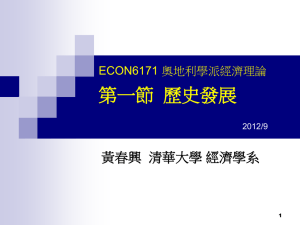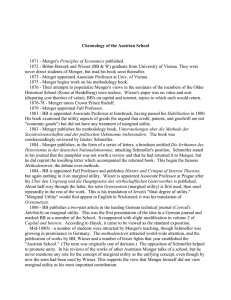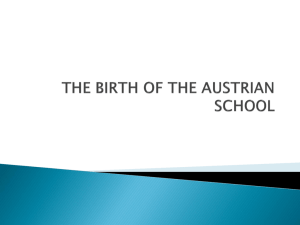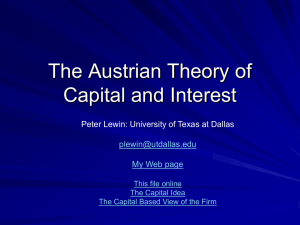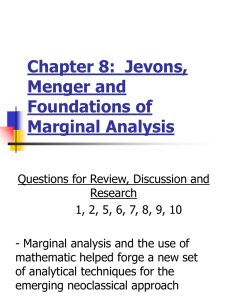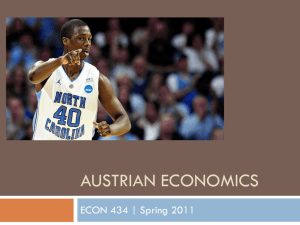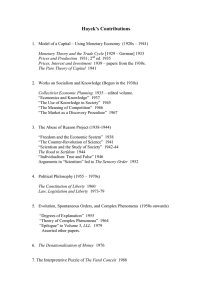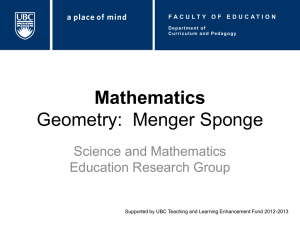Grundsatze, 1872 - Böhm-Bawerk and Wieser (BB & W) graduate from... never direct students of Menger, but read his book soon...
advertisement
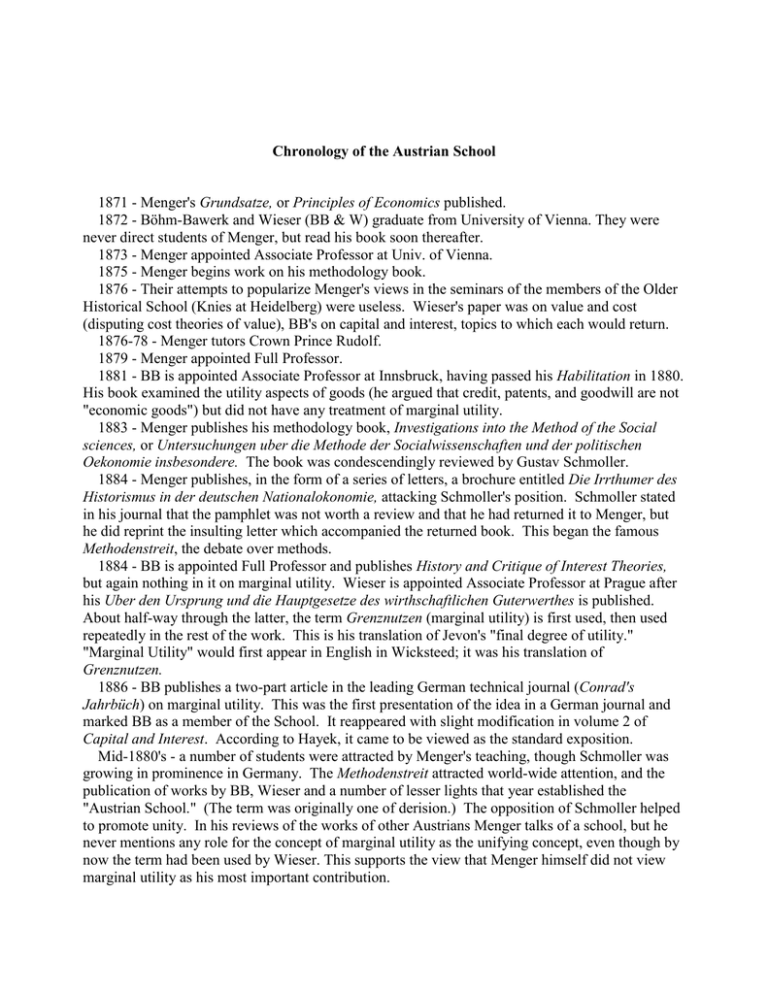
Chronology of the Austrian School 1871 - Menger's Grundsatze, or Principles of Economics published. 1872 - Böhm-Bawerk and Wieser (BB & W) graduate from University of Vienna. They were never direct students of Menger, but read his book soon thereafter. 1873 - Menger appointed Associate Professor at Univ. of Vienna. 1875 - Menger begins work on his methodology book. 1876 - Their attempts to popularize Menger's views in the seminars of the members of the Older Historical School (Knies at Heidelberg) were useless. Wieser's paper was on value and cost (disputing cost theories of value), BB's on capital and interest, topics to which each would return. 1876-78 - Menger tutors Crown Prince Rudolf. 1879 - Menger appointed Full Professor. 1881 - BB is appointed Associate Professor at Innsbruck, having passed his Habilitation in 1880. His book examined the utility aspects of goods (he argued that credit, patents, and goodwill are not "economic goods") but did not have any treatment of marginal utility. 1883 - Menger publishes his methodology book, Investigations into the Method of the Social sciences, or Untersuchungen uber die Methode der Socialwissenschaften und der politischen Oekonomie insbesondere. The book was condescendingly reviewed by Gustav Schmoller. 1884 - Menger publishes, in the form of a series of letters, a brochure entitled Die Irrthumer des Historismus in der deutschen Nationalokonomie, attacking Schmoller's position. Schmoller stated in his journal that the pamphlet was not worth a review and that he had returned it to Menger, but he did reprint the insulting letter which accompanied the returned book. This began the famous Methodenstreit, the debate over methods. 1884 - BB is appointed Full Professor and publishes History and Critique of Interest Theories, but again nothing in it on marginal utility. Wieser is appointed Associate Professor at Prague after his Uber den Ursprung und die Hauptgesetze des wirthschaftlichen Guterwerthes is published. About half-way through the latter, the term Grenznutzen (marginal utility) is first used, then used repeatedly in the rest of the work. This is his translation of Jevon's "final degree of utility." "Marginal Utility" would first appear in English in Wicksteed; it was his translation of Grenznutzen. 1886 - BB publishes a two-part article in the leading German technical journal (Conrad's Jahrbüch) on marginal utility. This was the first presentation of the idea in a German journal and marked BB as a member of the School. It reappeared with slight modification in volume 2 of Capital and Interest. According to Hayek, it came to be viewed as the standard exposition. Mid-1880's - a number of students were attracted by Menger's teaching, though Schmoller was growing in prominence in Germany. The Methodenstreit attracted world-wide attention, and the publication of works by BB, Wieser and a number of lesser lights that year established the "Austrian School." (The term was originally one of derision.) The opposition of Schmoller helped to promote unity. In his reviews of the works of other Austrians Menger talks of a school, but he never mentions any role for the concept of marginal utility as the unifying concept, even though by now the term had been used by Wieser. This supports the view that Menger himself did not view marginal utility as his most important contribution. 1888 - Menger publishes "Zur Theorie des Kapitals" - this critique of capital theories was probably due to Menger not particularly liking Böhm's first volume of Capital and Interest. 1889 - Menger was pressed through the 1880's to bring out a new edition of his Grundsatze, but by the late 1880's the others' works were more popularly read and Menger wanted no translation of the original until he had revised it. In 1889 he wrote the preface for a new edition, but the publication of it was again postponed. The preface is contained in the second 1923 posthumous edition. 1889 - a big year. BB's Positive Theory of Capital, Wieser's Natural Value (for which he was awarded a full professorship, though it ended up not being an important book in terms of later influence), and 4 other works by members of the Austrian School are published. Their views begin to attract attention around the world: Panteleoni exposits doctrines in Italian in 1889, Gide does so later in France. Their ideas found a particularly warm reception in Holland and the U.S., the latter due to the presentations of Patten and Ely. Marshall's first (1890) edition of Principles showed more of Menger's influence than did later editions. This was also the year that BB left the University to enter the Ministry of Finance. He continues to teach a few hours each week as an unpaid professor in Vienna. 1892 - Menger publishes an article on money for the German encyclopedia of political science. He applies the individualist and subjective approach to the determination of the value of money, to causes in the change of its value, to its measurement, etc. This treatment was to be extended by Mises in his 1912 book. Also in this year he entered into debates on the reform of the Austrian currency. 1903 - Menger retires prematurely from his professorship, either to work on his book or possibly (from Streissler) because he had fathered an illegitimate son, the mathematician Karl Menger. Wieser replaces him. 1904 - Upon retirement from the Finance Ministry, BB is attached to the University of Vienna. BB shared power with Wieser during the pre-war decade, and actually had the greater influence. Some of the students who attended his seminar included Mises, Schumpeter, Rudolf Hilferding, Otto Neurath, and Otto Bauer. 1912 - Mises publishes German version of The Theory of Money and Credit 1914 - death of BB. 1918 - Hayek enters the University of Vienna. 1921 - Menger dies in Vienna at age 80 plus three days. 1921 - Hayek works in a government office under Mises; Mises' Socialism comes out the next year and has a great influence. He forms a discussion circle which includes Machlup, Morgenstern and Haberler. 1923-24 - Hayek visits the US and meets Mitchell. On his return he becomes a member of the Mises privatseminar. 1926 - death of Wieser. Late 1920's - Hayek is the Director of the Austrian Institute for Trade Cycle Research, brings in Morgenstern. Passes his Habilitation and publishes the German version of Monetary Theory and the Trade Cycle. Meets Keynes on one of his trips to London. Robbins the department chair in Economics at the LSE in 1929. 1931 - Gives four lectures at the LSE on Robbins' invitation. Appointed Tooke Professor at the LSE at the end of the year at age 32. Prices and Production published. 2 1930s - The battles with Keynes and Cambridge on business cycle theory, with Knight on capital theory, and with the market socialists. See my articles "Hayek's Transformation" in HOPE and “Hayek and Socialism” in the JEL. Keynes wins the day. Hicks later emerges as the dominant neoclassical Keynesian: IS-LM and indifference curves (Hayek brought Pareto to his attention!) 1944 - The Road to Serfdom. See my “Editor’s Introduction” for story of its origins, reception, and the impact of the Reader's Digest condensation. 1947 – Haeyk founds the Mont Pèlerin Society. 1949 - English translation of Mises' Human Action. 1950 - Hayek moves to Chicago, not in Economics Department but on the Committee for Social Thought. Knight, Friedman, Aaron Director, and later Stigler were all at Chicago. 1960s and 1970's – Hayek works on political theory and the theory of complex phenomena. The Constitution of Liberty (1960) and the trilogy Law, Legislation and Liberty (1973-78) are major results. 1974 - co-recipient of Nobel Prize with Swede Gunnar Myrdal. They are from the opposite ends of the political spectrum, and neither was happy with receiving the award with the other. Both awards mention their earliest non-ideological work. Mid-1970's - Austrian revival begins. Program established at NYU under Israel Kirzner, later another at GMU with Don Lavoie and later Pete Boettke, Don Boudreaux and others. Many American Austrians were followers of Mises, who had a seminar at NYU during the 1950s and 1960s. Murray Rothbard and Israel Kirzner were students. Rothbard later emerges as a leader of the anarcho-capitalism movement, more radical anti-statists than either Hayek or Mises. The Mises Institute at Auburn University has a strong Rothbardian influence. Also a great website for accessing literature. For a readable but well documented introduction to the libertarian movement that covers the Austrians and the Chicago School, as well as early antecedents from colonial times through the 1930s and 1940s, Ayn Rand, think tanks, foundations, the strange relationship of Rothbard with the New Left, and much more, see Brian Doherty’s Radicals for Capitalism: A Freewheeling History of the Modern American Libertarian Movement (N.Y.: Public Affairs, 2007). 3
